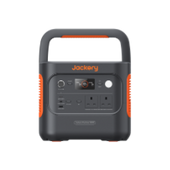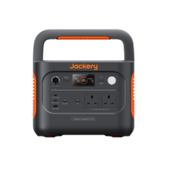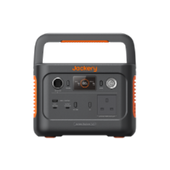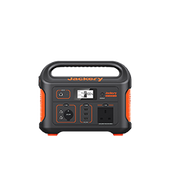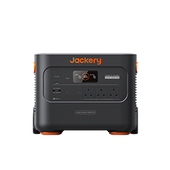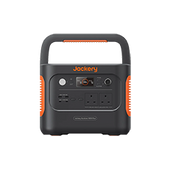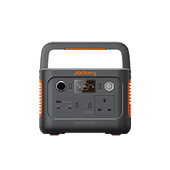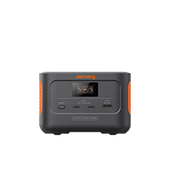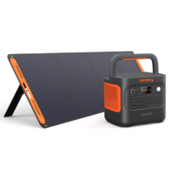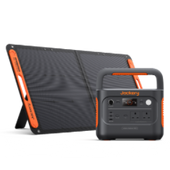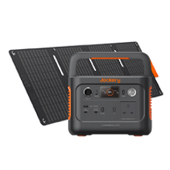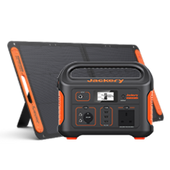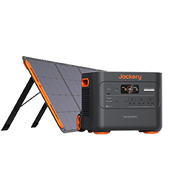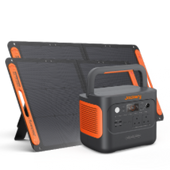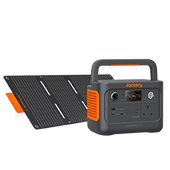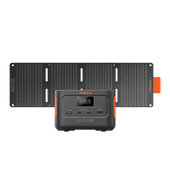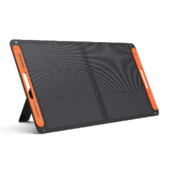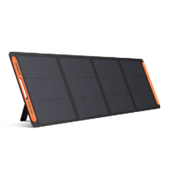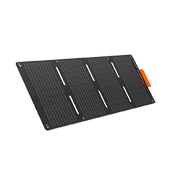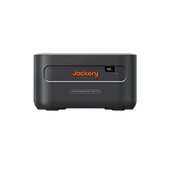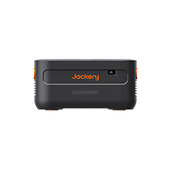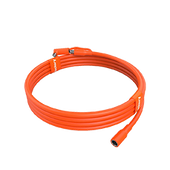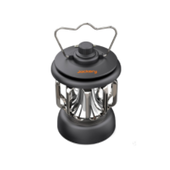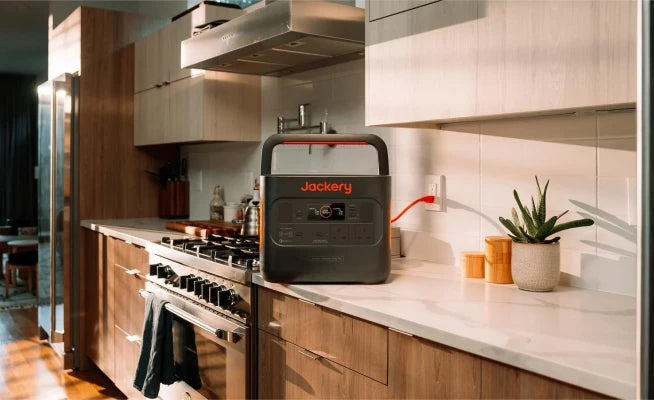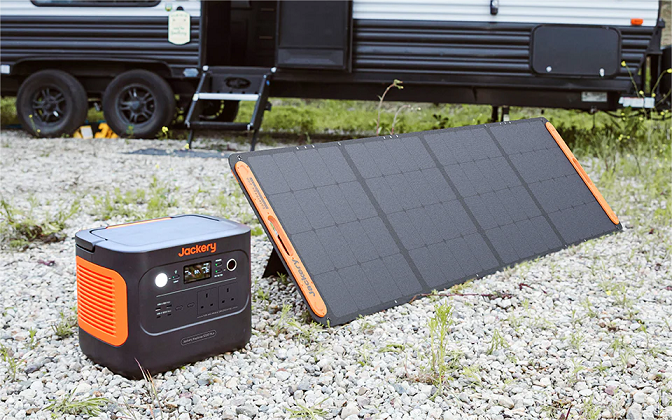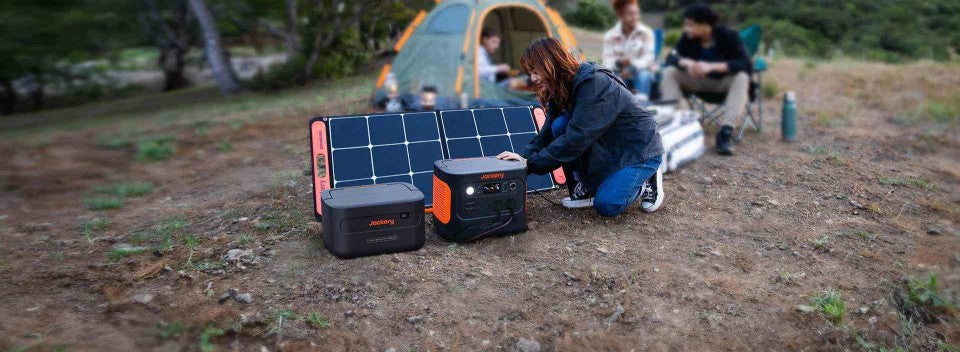In recent years, solar energy technology has become increasingly popular. When the sun's radiation energy is converted into heat and electricity, it can provide energy for homes and businesses. In short, the future of solar energy is promising.
Solar energy offers great promise as a clean, reliable energy source. When converted into heat and electricity, it can provide energy for homes, businesses, and even vehicles.
It is important to know how solar energy works. If you want to try solar energy cost-effectively, we recommend Jackery Solar Generator, a portable solar system that combines Jackery Solar Panels with a Portable Power Station to turn sunlight into electricity.
|
Key Takeaways: |
|
- Solar energy is a clean energy form that uses solar radiation for energy conversion and utilisation. - Solar inverters transform direct current (DC) electricity into alternating current (AC) electricity, which is the type of electrical current utilised by appliances when connected to a regular wall outlet. - In recent years, solar energy technologies have been increasingly used. There are two types of solar energy technologies: solar panel systems and solar thermal systems. - Despite solar energy's apparent benefits and growing popularity in the UK, many challenges remain to its practical application. - We recommend Jackery Solar Generator 2000 Plus and 1000 v2, portable solar systems for charging appliances and electronics indoors and outdoors. |
Solar Energy Overview
Solar radiation is light, or electromagnetic radiation, emitted by the sun. Although every location on Earth receives sunshine throughout the year, the quantity of solar energy that reaches a certain point on the Earth's surface differs. Solar technologies harness this radiation and convert it into valuable types of energy.
Solar energy refers to the light and thermal energy emitted by the sun. To comprehend its production, we shall begin with the fundamental unit of solar energy: the photon. Photons are both waves and particles generated by nuclear fusion at the sun's core, the hottest region.
The sun's centre reaches an astonishing temperature of 27 million degrees Fahrenheit. This intense temperature and pressure induce collisions between hydrogen atoms, resulting in the formation of helium. The reaction emits substantial quantities of energy as photons.
How Does Solar Energy Work?
Solar energy provides light and heat to the Earth. Solar radiation includes visible light, invisible ultraviolet rays, and infrared rays, of which visible light and part of infrared rays are the primary sources of heat energy conversion. Humans have developed various technologies to utilise this unlimited energy, the most common of which are photovoltaic power generation and solar thermal utilisation. So, how does solar energy work?
How Does Solar Panel System Work?
Solar panels produce energy when photons, the particles of sunshine, impact solar cells. This phenomenon is referred to as the photovoltaic effect, first identified in 1839 by Edmond Becquerel. The photovoltaic effect is a property of some materials, termed semiconductors, enabling them to produce an electrical current upon exposure to sunshine.
Approximately 95% of solar cells comprise silicon, a nonmetallic semiconductor capable of absorbing and converting sunlight into electricity via the photovoltaic effect. This is the operational procedure:
Photovoltaic power generation's core component is a solar panel, also known as a photovoltaic panel. The following is the basic working principle of photovoltaic power generation:
Step 1: Photon Absorption
The semiconductor material inside the cell, such as silicon, absorbs photons (light particles) from sunlight.
Step 2: Electron Excitation
Electrons that absorb photon energy will jump from the valence band (energy level with lower electron energy) to the conduction band (energy level with higher electron energy).
Step 3: Electric Field Effect
The p-n structure usually generates a built-in electric field inside the solar cell. Near the p-n junction, the concentration difference between electrons and holes forms a built-in electric field.
Step 4: Current Generation
Under the action of the built-in electric field, an electric current is formed.
The following is a schematic diagram of photovoltaic power generation:

What Are Solar Panels Made of?
Photovoltaic (PV) panels are produced as solid, fully sealed units, minimising the possibility of hazardous exposure to poisonous substances. Photovoltaic panels are frequently deployed in desert and arctic locations and are engineered to be entirely weatherproof under all climatic conditions. The surface is often tempered glass, while the rear panel is securely sealed to encapsulate the solar cells between the glass and the back panel.
The photovoltaic panels are constructed as a solid, sealed unit, preventing any chemicals from being washed off by water, as there are no liquids within the solar panels. Moreover, the substances in photovoltaic panels do not volatilise, and the panels possess a melting point that surpasses that of most conventional fires.
Specific photovoltaic panels utilise silicon in their solar cells. Silicon is a prevalent substance in various soils, sands, and rocks. A minimal quantity of lead-containing solder is utilised to join the solar cell wires; however, since the cell is encapsulated within the panel, this negligible amount of solder cannot escape the panel.
How Does Rooftop PV Work?
A photovoltaic (PV) system typically consists of many solar panels, which are installed on the roof of a standard residence or small enterprise.
Sunlight generates power as direct current (DC), which is subsequently transmitted to an inverter that converts the DC into alternating current (AC), as household appliances and lighting are configured for AC electricity.
This alternating current (AC) electricity can thereafter be utilised in residential or commercial settings, transmitted to the electric grid, or sold to the utility provider.
In hybrid systems, power can be utilised within the home, and any surplus can be sold to the utility provider. The decision to utilise power, sell it, or pursue both alternatives in the hybrid model is contingent upon the policies provided by your utility.
How Does Ground-Mounted PV Work?
Utility-scale, ground-mounted photovoltaic systems are deployed to generate solar electricity for the electrical grid, akin to conventional power plants. After the direct current (DC) power is generated, inverters change it into usable alternating current (AC) electricity, which is subsequently directed to a transformer before reaching a substation.
At the substation, electricity is transformed into a voltage suitable for utility grid transmission lines. It is either supplied to the electrical grid to fulfil local community needs or transmitted to other regional areas and/or states.
How Does Solar Thermal Work?
Solar thermal utilisation is a technology that heats water or other media through solar radiation to provide hot water, heating, or cooling. The core of solar thermal utilisation is converting solar radiation into thermal energy, which mainly relies on solar collectors. The collector absorbs sunlight, converts it into thermal energy, and transports the heated fluid.
The following is a working diagram of solar thermal utilisation:

Types of Solar Energy Technologies
After learning how solar energy works, knowing about solar energy technologies is essential. Solar energy technologies are a form of clean, renewable energy that uses solar radiation for energy conversion and utilisation. In recent years, solar energy technologies have been increasingly used. The following are two types of solar energy technologies that are currently being used:
Photovoltaic Power Generation Technology
Its leading equipment is a photovoltaic panel, formed by connecting multiple photovoltaic panels in series or parallel to form a photovoltaic power generation module. The module converts direct current into alternating current through electronic devices to supply electricity to homes, factories, and commercial use.
Grid-Connected Solar Photovoltaic System
Grid-connected solar photovoltaic systems are directly connected to the existing power grid, enabling homeowners and businesses to generate electricity while obtaining additional electricity from the grid when needed.
Off-Grid Solar Photovoltaic System
Off-grid solar photovoltaic systems operate independently of the primary power grid and are ideal for remote areas and independent installations that cannot be connected to the grid. They are usually equipped with energy storage devices.
Energy Storage Solar Photovoltaic System
Energy storage solar photovoltaic systems combine photovoltaic power generation and energy storage technology to provide backup power when the grid is unstable or outages occur. This system is particularly suitable for application scenarios with high power reliability requirements.
Except for rooftop or ground-mounted solar panel systems, solar generators are also a type of energy storage solar PV system. For example, Jackery Solar Generator combines Jackery Solar Panels with a Portable Power Station to turn sunlight into electricity.
|
PV Application |
Advantages |
Disadvantages |
|
Grid-Connected Solar Photovoltaic System |
• Low-cost • Easy maintenance • Intelligent management • No energy storage loss • Policy support |
• Dependence on the power grid • Limited by the power grid • No backup power |
|
Off-Grid Solar Photovoltaic System |
• Independent operation • Stable power supply • Emergency backup • Flexible installation • Environmental protection and energy saving |
• High cost • Complex maintenance • Energy loss • Affected by weather |
|
Energy Storage Solar Photovoltaic System |
• Flexible and efficient • Reduced electricity cost • Enhanced reliability |
• High cost • Complex maintenance • Energy loss |
Solar Thermal Utilisation Technology
Solar thermal utilisation technology refers to using solar radiation to generate heat energy. It mainly includes solar water heaters, hot air furnaces, solar thermal power generation, etc.
Solar Water Heater
Solar water heaters mainly comprise collectors, water tanks, and brackets. Collectors usually adopt various forms, such as vacuum, glass tubes, and flat plates.
Solar Air Conditioning
Solar air conditioning uses the heat energy generated by solar energy to drive the air conditioning system to achieve cooling or heating. The system mainly includes collectors, compressors, evaporators, etc. The solar collector converts solar energy into heat energy, then transfers the heat energy to the compressor and realises the air conditioning function through the refrigeration cycle.
Solar Thermal Power Generation Technology
Solar thermal power generation technology mainly converts solar radiation into heat energy by concentrating solar collectors, generating electricity through turbines and generators. According to the different focusing forms, concentrated solar thermal power generation systems mainly include tower, trough, and dish types.
|
Solar Thermal Applications |
Advantages |
Disadvantages |
|
Solar Water Heaters |
• Energy saving and environmental protection • Economic benefits • High safety • Long service life |
• Complex installation • Reliant on sunlight • Troublesome maintenance |
|
Solar Air Conditioners |
• Seasons have a strong impact • Environmental protection • High comprehensive benefits • Reduced building load |
• Vulnerable to weather • High initial investment • High maintenance cost • Limitations |
|
Solar Thermal Power Generation Technology |
• Environmentally friendly and clean • Large power generation • Store energy • Long-term economic benefits |
• Occupies a large area • Limited by geographical location • Low efficiency • Large initial investment |
The diverse applications of solar energy technologies can reduce dependence on traditional energy and bring more convenience and economic benefits to our lives. With the continuous advancement of technology and reduced costs, solar energy technologies will play an increasingly important role in the future energy transformation.
Jackery Solar Generators Explained
A solar generator harnesses and stores solar energy in a portable power station utilising solar panels. It emits no hazardous gases, operates cleanly, and inflicts no environmental damage. Jackery Solar Generators transform sunshine into electricity, providing a dependable power source for camping, RVing, off-grid living, and home backup.

Jackery Solar Generators possess rapid solar charging capabilities, enabling the power stations to be charged within a few hours. The solar panels utilise monocrystalline silicon solar cells and possess an exceptional efficiency rate of 25% to facilitate rapid charging. For further convenience, the power stations can also be recharged via car chargers or wall plugs.
|
Appliances |
Working Hours |
|
|
Jackery Solar Generator 1000 v2 (1070Wh) |
Jackery Solar Generator 2000 Plus (2-12 kWh) |
|
|
Refrigerator (700W) |
1.2H |
2.4-14.6H |
|
Computer (200W) |
4.3H |
8.5-51H |
|
Phone (10W) |
85.6H |
174-1020H |
|
Lighting (50W) |
17.1H |
34-204H |
|
Portable Heater (1000W) |
0.9H |
1.7-10.2H |
Jackery Solar Generator 1000 v2
Firstly, we introduce Jackery Solar Generator 1000 v2, an Explorer 1000 v2 portable power station combo with SolarSaga 100W or 200W solar panels. We will introduce each component in detail.

The Explorer 1000 v2 Portable Power Station provides an impressive 1500W output, 50% greater than earlier models, efficiently supplying power to high-demand devices such as refrigerators, kettles, and portable heaters. Equipped with USB-A/C connections and dual PD charging up to 100W, it can simultaneously charge several devices (phone, laptop), rendering it the ideal companion for all your power requirements.
The Emergency Charge Mode, activated via the app, enables the Explorer 1000 v2 Portable Power Station to achieve a full charge in under one hour, providing essential power backup when the battery is depleted. Moreover, charging from 0% to 100% within two hours via an AC wall outlet prolongs battery longevity.
Experience peace with its nearly silent operation, maintaining noise levels below 22dB while charging your devices. Compared to other traditional generators, this one is more suitable for home use and has sufficient power capacity.
Achieve reduced weight and enhanced performance with a cutting-edge solar system. The 100W bifacial high-efficiency solar panel, featuring a conversion rate of up to 25%, integrates advanced IBC technology with a sleek black design, enhancing power generation while minimising weight.
|
*Review from Our User |
|
First, this item is robust and space-efficient, fitting seamlessly in my workspace (see pic). When the power goes out, it becomes a real game changer. I can continue my tasks as if everything is normal, which is impressive. The most advantageous aspect for me? The USB-C ports. I can connect my Mac directly to it without needing an adapter. Incredibly useful! |
Jackery Solar Generator 2000 Plus
Jackery Solar Generator 2000 Plus is more powerful and versatile than 1000 v2. It is a solid portable solar energy solution that pairs Explorer 2000 Plus with SolarSaga 200W solar panels and delivers outstanding performance. With its impressive capacity and powerful output, this device can support the operation of essential appliances for weeks, even certain large appliances.

The Jackery Solar Generator 2000 Plus enables the addition of extra battery packs, increasing the capacity from 2 kWh to an impressive 12 kWh, thereby significantly satisfying your power needs. This solar product has a remarkable output of 3000W, which is almost all essential appliances indoors or outdoors.
The Explorer 2000 Plus stands out as a groundbreaking add-on battery pack that offers the convenience of recharging through solar panels, wall outlets or carports. This feature increases versatility, boosts charging efficiency, and shortens charging time. Also, it can be taken indoors safely compared to other traditional generators.
ChargeShield is Jackery's advanced fast charge technology, featuring 62 protective mechanisms, 12 protective algorithms, and four types of physical safety protection. This technology uses a unique stepped variable-speed charging algorithm to enhance safety and extend battery pack lifespan by 50%.
Jackery solar panels generate more lifetime energy due to their industry-leading solar conversion efficiency of up to 25%. Our solar panels generate 50% more energy in low-light circumstances than conventional solar panels (PERC) and exhibit superior spectrum responsiveness.
Operates at an exceptionally low noise level of about 30dB.
|
*Review from Our User |
|
I have been using Jackery batteries for a long time. I felt great excitement upon the release of the Explorer 2000 Plus, which marks the inaugural release of an expendable battery system by Jackery. The system supports a capacity of up to 12kWh with a 3000W 120V output or 24kWh with a 6000W 240V output—an ideal enhancement for my home backup system. |
Why Is Solar Energy Important in the UK?
Although the UK is known for its rainy weather, solar energy has gradually become indispensable in its energy structure in recent years. Multiple driving factors, from environmental benefits to policy support to technological progress and economic considerations, explain the increasing importance of solar energy in the UK. Here are a few key reasons solar energy is essential in the UK.
Environmental Benefits
Solar energy is essential to achieving the UK's "net zero" emissions target. Compared with traditional thermal power generation, solar power does not produce pollutants and greenhouse gases, which helps reduce the environmental burden.
Economic Benefits
The popularity of solar energy can create green jobs and promote economic development. Developing the solar energy industry requires many installation and maintenance personnel and involves multiple links such as research, development, and manufacturing, which can bring many jobs to the UK.
Energy Security
Generally, relying on a single energy source increases a country's energy security risks. As a local and renewable energy source, solar energy can help reduce the UK's dependence on imported fossil fuels and improve energy self-sufficiency. Especially in abundant sunshine, solar energy can be an essential supplement to the UK power grid and even become the primary power source at certain times. By developing a diversified energy structure such as solar energy, the UK can better cope with fluctuations in the international energy market and ensure the stability of long-term energy supply.
Dealing with Extreme Weather Events
Extreme weather usually challenges the stability of traditional energy systems. As a distributed energy source, solar energy can alleviate the pressure on the power grid to a certain extent, especially during peak power consumption. In addition, solar energy can complement other renewable energy sources (such as wind energy).
Technological Progress and International Cooperation
From a global perspective, the development of renewable energy technology has become a new area of competition among countries. By increasing research and development in renewable energy technologies such as solar energy, the UK can gain benefits in the domestic market and a foothold in the international market.

Challenges of Using Solar Energy in the UK
Despite solar energy's apparent benefits and growing popularity in the UK, many challenges remain to its practical application.
Here are some of the main challenges that the UK needs to deal with when using solar energy:
Weather and Climate Conditions
The UK's temperate maritime climate is known for its rainy and cloudy days, which directly affects the efficiency of solar power generation. In addition, the UK's high latitude and relatively short sunshine hours (especially in winter) limit the power generation of solar panels. Therefore, compared with sunny areas, the power generation of solar energy in the UK is still low.
Cost
Although the cost of solar panels has dropped significantly in the past decade, it is still an expensive investment for many homeowners and businesses. Although solar energy systems can recover costs through power generation, this process may take years.
Technical Challenges
Although technological advances have made solar power generation more efficient, it still faces some technical bottlenecks. For example, although space solar power generation has potential, problems such as the weight of solar panels still need to be solved. In addition, solar power generation is intermittent, and an effective energy storage system is required to ensure power supply stability.
Market Competition
The UK solar manufacturing industry is under tremendous pressure due to overcapacity and fierce competition in the global solar industry. Companies like BP have chosen to exit the market because the solar business is not profitable.
Inadequate Infrastructure
With the increased solar power installed capacity, the UK's power grid faces tremendous integration pressure. The existing grid infrastructure may not effectively handle the large-scale access of intermittent energy, which requires a lot of investment to upgrade and transform the grid.
Public Acceptance
Although solar energy has been widely recognised as a green energy source, some public members still misunderstand and doubt it. For example, some people are worried that solar energy systems will affect the house's aesthetics. Others believe it cannot work effectively under the UK's climate conditions. Therefore, developing a public participation and communication strategy is necessary to alleviate the public's negative perception of them.
What Is the Future of Solar Energy in the UK?
With the government's emphasis on clean energy and continuous technology innovation, the UK's solar energy industry has significantly progressed in recent years.

The Current Status of Solar Energy in the UK
The UK's solar energy industry has grown steadily in recent years. The UK government has effectively promoted the early deployment of solar projects through incentives such as feed-in tariff subsidies, especially in the residential and commercial rooftop markets. Even with the gradual reduction of national subsidies, the development of solar projects remains on the rise.
Strategies to Promote the Development of Solar Energy in the UK
By implementing an effective strategy, the UK is expected to achieve a world-leading position in solar energy development and achieve the goals of energy transformation and a low-carbon economy. The British government, businesses and the public should work together to seize the historical opportunity for solar energy development.
Here are some strategies to promote solar energy development in the UK:
Strategy 1: Develop a clear and ambitious solar energy strategy
Strategy 2: Improve policy support and subsidy mechanisms
Strategy 3: Simplify the approval process for the solar industry and lower the entry threshold
Strategy 4: Promote technological innovation and cost reduction
Strategy 5: Strengthen grid modernisation and energy storage technology development
Strategy 6: Improve public awareness and participation
Strategy 7: Encourage international cooperation in solar energy technology
Prospects for the Development of Solar Energy in the UK
With the advancement of technology and the reduction of costs, the competitiveness of solar power generation will be further enhanced. However, the solar energy industry in the UK still faces some challenges. For example, the intermittent problem of solar power generation and how to effectively store and dispatch solar power are urgent problems that need to be solved.
Despite some challenges, through continuous efforts and innovation, solar energy is expected to become an essential pillar in the UK energy system and contribute to realising sustainable development and net zero goals. For example, the realisation of space solar power stations will be a breakthrough, and it is expected to provide the UK with stable and large-scale clean energy. In short, the future development of solar energy in the UK is promising.
How Does Solar Energy Work FAQs
The following are the frequently asked questions about how solar energy works:
1. How does a solar energy system work?
A solar energy system is a technical device that converts solar radiation into electrical or heat energy. Its working principle involves several key parts and steps.
|
Solar Panel |
Conversion of light energy to electrical energy |
|
Inverter |
Conversion of DC to AC power |
|
Energy Storage System |
Storage and use of electrical energy |
|
Control System |
Intelligent management and monitoring |
2. Do solar panels work in winter?
Solar panels can be used in winter, and the situation in many regions shows they can still work effectively in winter. However, there are several challenges to using solar panels in winter:
Reduced light hours
Weak light intensity
Snow accumulation problem
In short, by taking appropriate measures, such as increasing the number of panels and regularly cleaning and maintaining them, you can ensure that solar panels can still be used in winter.
3. How do solar panels send electricity back to the grid?
An inverter is a crucial component of a solar energy system. It is a device that transforms direct current (DC) electricity produced by a solar panel into alternating current (AC) electricity, which is utilised by the electrical grid.
Final Thoughts
By know how solar energy works is important for using this renewable energy. In short, solar energy's importance to human society is reflected in environmental benefits, economics, security, social aspects, and other aspects. Although the current development of solar energy also faces some challenges, with the continuous advancement of technology, solar energy will play an increasingly important role in the world's energy transformation.

